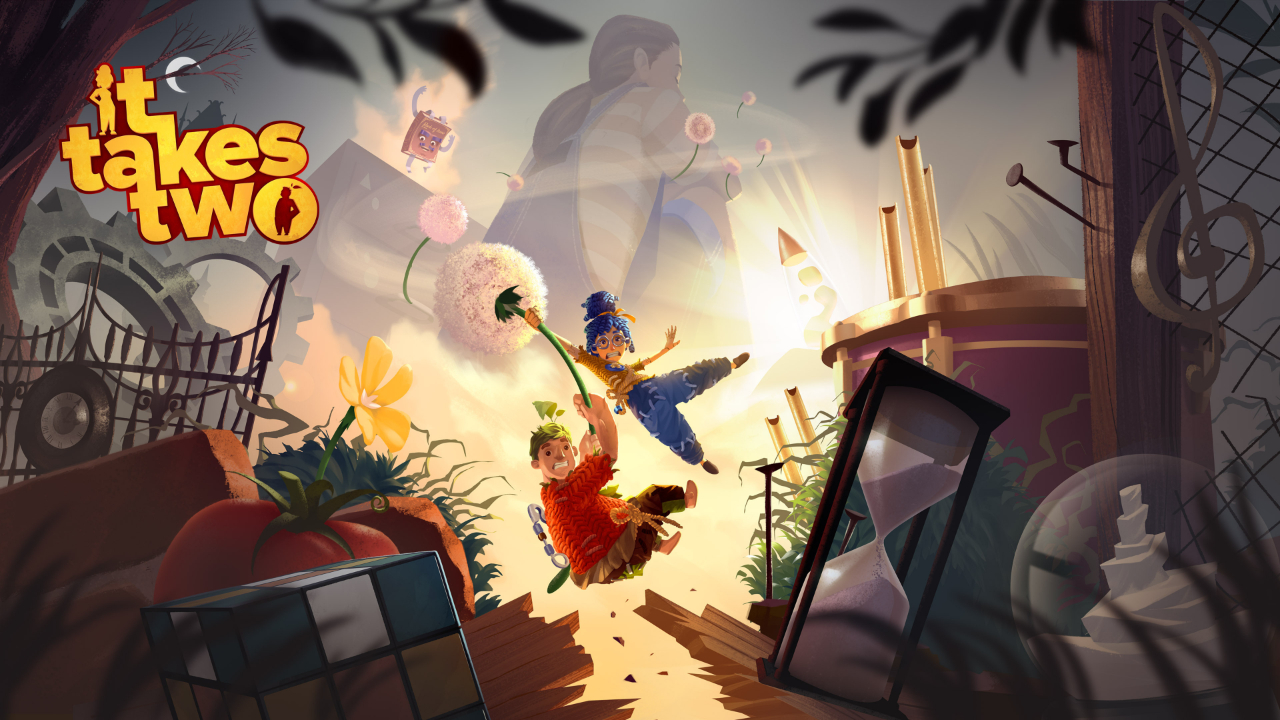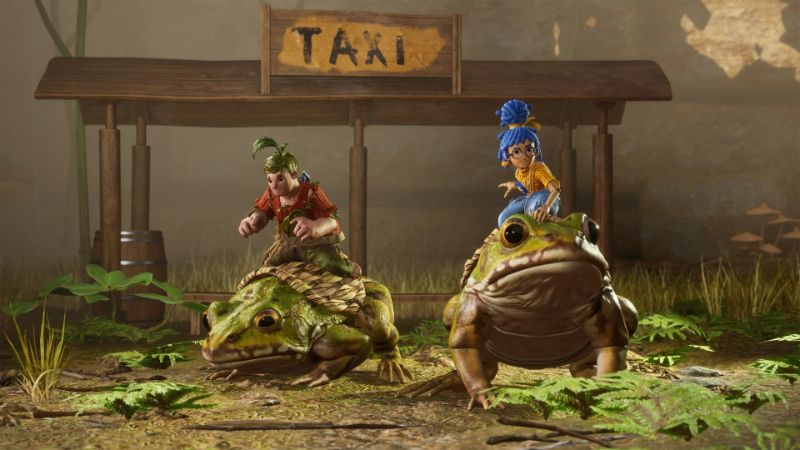In 2013, Brothers: A Tale of Two Sons reinvented co op as a single-player experience no one had seen before. In 2018, A Way Out became a co op game built on permanent split-screen and tough compromises. Now in 2021, Director Josef Fares and developer Hazelight have mastered their last decade of ideas in a new experience, It Takes Two.
While the game misses its narrative mark as a heartfelt journey of two soon-to-be divorcees, level design, gameplay mechanics, and music are all so varied that you’d never know this is an EA Originals game. It feels like a big-budget success story.
It Takes Two offers variety in its gameplay that I didn’t think possible, but what’s more impressive is it matches that quantity of experiences with consistent quality.
It Takes Two Review: A Genre-Bender Like No Other
In It Takes Two, May and Cody are splitting up. It’s a sad place to start the story, and even sadder for their daughter, Rose. Like most kids, Rose doesn’t want her parents to get divorced and blames herself for their intentions to do so.
It’s not long before the game’s fantastical premise takes over, foregoing some quasi-sci-fi explanation as to why the couple is morphed into toy dolls Rose made. Instead, they and players alike are quickly thrust into their new little-big world where suddenly wasps are kamikaze pilots, squirrels are hardened soldiers of a backyard war, and stuffed animals like Moon Baboon are Rose’s protectors, shielding her from the hurt caused by her parents’ latest scuffle.
Like with A Way Out, It Takes Two operates on mandatory co op. The game is almost always played in split-screen, and each character always has their own unique abilities, no matter the scene.
In that regard, It Takes Two is the college thesis to A Way Out‘s high school book report. Gameplay variety is on a level that I don’t know anyone’s ever seen. Led by the permanently gyrating, anthropomorphic Book of Love, Dr. Hakim, the couple works through counseling by way of 15 or so hours of platforming excellence.
There is a startlingly low number of revisited mechanics, to the point that the game feels at odds with how I understood game dev to work for as long as I’ve been alive. Whereas you typically build a foundation, then add layers to it with each successive gameplay hour, It Takes Two chucks that book into the fireplace. Early on, with my wife as my co op partner, I flew a plane crafted from my human-sized underpants through the backyard while my wife battled a squirrel in a 2D fighting game on the wings, with health bars and all.
In the opening hours, the game gifts Cody with nails and May with a hammer, and they use their unique abilities to solve problems along the way, like May smashing a board into a horizontal position, then Cody quickly nailing it in place, so it becomes a new platform to jump from.
Later on, they get new tools, like a nectar gun and flamethrower, the ability to clone herself or his move that can stop or rewind time, and much more.
Each of the game’s seven chapters follows this format. A new location brings brand new tools, and no two levels play, look, or sound at all alike. There are some sections that change things so drastically that I don’t even want to spoil them here. There are also lots of fun homages to other games, like a race on a familiar-looking Rainbow Road and a daring escape level where the player runs toward the camera a la Crash Bandicoot.
As a platformer, It Takes Two is reliably precise, unforeseeably varied, and celebratory of the genre greats that came before it.
Just imagine a game where your camera perspective, gameplay mechanics, and set design are all up for debate. How Hazelight could make a game like this, with seemingly so few reused assets, such a wide variety of musical stylings to suit each setting, and most of all, the everchanging UI and gameplay tentpoles, has truly blown my mind over the past few days of playing it.
It’s not only that each chapter brings new central mechanics, it’s that each of them even introduces one-off sections, like the 2D fighter or an extended action-RPG scene, that would impress us quickly, then disappear forever. In the best way possible, it hurts my brain to wonder how this game was made. It seems like one should have to sacrifice polish for variety or vice versa, but It Takes Two masters both at once in a way I don’t think the medium has ever seen.
Just to really show off, the game even features 25 hidden mini-games players can discover through exploring each level, thus introducing yet a greater variety of elements at every turn. Things like Whack-a-Mole, chess, shuffleboard, and some wholly new ideas are sprinkled through each level and can be replayed at any time from the menu. The game even tracks all-time and per-game scores, so you and your co op partner can fight for bragging rights.
On new-gen consoles, the game is already optimized as well, so on top of it playing and sounding excellent, it looks that way too, with the game seemingly running at a high framerate despite the split-screen, which I always heard made that sort of thing very hard. It Takes Two feels like a miracle in game design.
It Takes Two intends to hang its hat on its unpredictable design, but it ends up owing a bit more than expected because narratively, the story doesn’t really carry its weight. Cody and May’s relationship should be an interesting one to explore through this Pixar-like lens, but they rarely come off as earnest and only really do so at the very end. Cody is permanently sarcastic and May forever exasperated. It makes it so the physical progress they make as toys is never quite correlates emotionally, even as the game suggests it should.
Dr. Hakim’s involvement is also a superfluous one as he only serves to spoon-feed the game’s metaphors to the player, like May’s cloning ability being a stand-in for her busy schedule, or Cody’s dream of gardening rotting away like the actual garden the couple explores in a late chapter. Without the intended heart of these characters shining through, the space between each remarkable setpiece and every unpredictable new mechanic is left feeling lackluster.
It Takes Two Review — The Bottom Line
Pros
- Gameplay variety on a level of its own
- Polished, gorgeous, and ever-changing levels
- Music is just as varied to suit every new setting
- Fun minigames to discover
Cons
- Characters never quite sell the heart of the story
- Routinely spells out its metaphors
It Takes Two is a game marvelously directed but only middlingly written, thus souring some of its lasting impact overall. Though the story never lands as intended, it’s enjoyable enough to act as the backdrop for all the unending fun there is to be had elsewhere.
From a gameplay standpoint, It Takes Two is one of the year’s greatest achievements. I say that confidently no matter what else comes out in the next nine months. I’ve simply never heard of a game doing this much on a presumably less-than-AAA-budget. Even then, I don’t think any game has really gone to the lengths this does, reinventing itself roughly every 15 minutes.
It Takes Two is one-of-a-kind.
[Note: Hazelight provided the copy of It Takes Two used for this review.]










Published: Mar 29, 2021 11:48 am